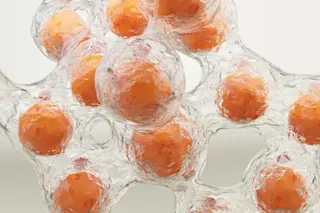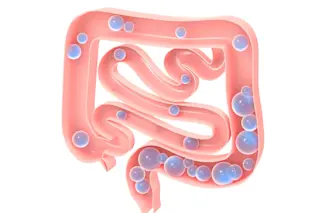Creutzfeldt-Jakob disease comes in two forms, one old and one new, both terrible and both rare. In both forms the victim suffers microscopic spongy holes in the brain; in both forms the holes are thought to be caused by prions, proteins that sit on the surface of brain cells and turn deadly only when they are—literally—bent out of shape. In the first form of the disease, which strikes late in life, the flaw in the prion is often genetic. But new variant cjd, which has killed at least 19 people in Britain in the past three years—all relatively young—is different: it’s thought to be transmissible. Its victims contracted the illness, according to the prevailing theory, by eating prion-laced beef from mad, spongy-brained cows—cows with bovine spongiform encephalopathy, or bse. That theory, when it was proposed in 1996, set off a panic that led other European nations to ban imported British beef and Britain to slaughter and incinerate over 37,000 head of cattle. In the fall two research groups reported resounding evidence that the theory is true.
The first report came from pathologist Moira Bruce of the Institute for Animal Health in Edinburgh. She took brain matter from mad cows, new-variant cjd victims, and conventional cjd victims and injected it into the brains of lab mice. She found that bse and new-variant cjd produced the same pattern of holes in the brains of the mice, as well as similar symptoms of the fatal disease—nervousness, lethargy, and hunched posture. The mice injected with conventional cjd, however, remained healthy.
The second report, by John Collinge of Imperial College School of Medicine at St. Mary’s in London, brought the evidence one step closer to humans. Collinge also injected mashed-up brains from bse-infected cattle and new-variant cjd victims into the brains of mice—but in his case the mice had been genetically engineered to carry the human version of the prion protein. After waiting almost two years, he found that both groups not only developed similar symptoms but harbored the same misshapen prion protein.
Neither piece of research proves that the young cjd patients got their disease from eating infected beef—mice are different from humans, and eating beef is different from having ground-up cow brains injected into yours. But the research shows that you cannot distinguish between bse and variant cjd—they’re the same thing, says virologist John Pattison of University College London, who chairs the British government’s Advisory Committee on Spongiform Encephalopathies. It doesn’t tell you precisely what the nature of that link is, although we do think that the most likely is exposure to beef products.
British cows, in turn, most likely got their disease from exposure to sheep products in their feed—the ground-up brains of sheep infected with scrapie, the ovine spongiform encephalopathy. Still, no one has managed to isolate the disease-causing agent from any animal and show that it alone—and not ground-up brain—will cause disease. The most widely held theory is that the agent is none other than a misfolded prion itself. The idea is that an abnormal prion ingested in food travels to the brain, where it somehow subverts the victim’s normal prion proteins, prompting them to flip their folds into the abnormal shape. Neurons die, holes form in the brain, and the transmissible prion propagates itself—all without the aid of genes, dna, or rna, for a prion is only a protein.
It is a revolutionary theory, with much evidence to support it but no proof, and many vocal critics, who think an exceptionally elusive virus will be found as the real cause of the spongiform diseases. Thus it came as a general surprise in October when the chief proponent of the prion theory, Stanley Prusiner of the University of California at San Francisco, received the Nobel Prize for, as the Karolinska Institute put it, his discovery of prions—a new biological principle of infection. It is rare for the Swedish prize givers to be so cutting-edge, and also rare for them to give the $1 million medicine prize to just one researcher.
No cases of mad cow disease have been reported in the United States yet, and the incidence of cjd here remained stable from 1979 to 1995, at about one case per one million people a year. Nonetheless, a recent cluster of five cjd cases in Kentucky, reported in August by neurologist Joseph Berger of the University of Kentucky in Lexington, is providing cause for concern. These five people had a dietary choice in common: they ate squirrel brains. Thirty-five million squirrels are hunted and killed each year throughout the United States, explains Berger, but in Kentucky one of the most common methods is to scramble the brains with eggs. The other is to include them in a stew called burgoo, where everything’s put in—vegetables and all sorts of rodent parts.
So far, the link between cjd and squirrel brains is tentative—there is no evidence that squirrels even get a spongiform disease. Berger is gathering squirrels from hunters in Kentucky to find out.














